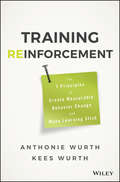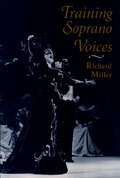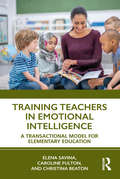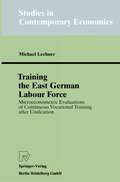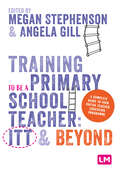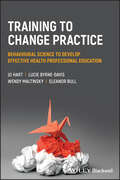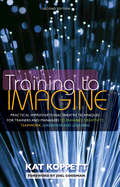- Table View
- List View
Training for Work in the Informal Micro-Enterprise Sector: Fresh Evidence from Sub-Sahara Africa (Technical and Vocational Education and Training: Issues, Concerns and Prospects #3)
by Hans Christiaan HaanIn Sub-Sahara Africa, the sector of informal micro-enterprises (IMEs) is already employing a large share of the labour force in both urban and rural areas. This study reviews the ways in which the owners and workers of IMEs have acquired their vocational and management skills. It reviews the contributions of all the different training providers, including public sector training institutes, private sector training providers, and training centres run by NGOs and other non-profit organizations. The study finds that informal apprenticeship training is by far the most common source of various skills - in some countries it is likely to be responsible for 80-90% of all ongoing training efforts. Informal apprenticeship training presents a number of important advantages. At the same time it has a number of limitations. The study concludes that there is a major challenge to improve the transfer of relevant skills to IME operators, both through pre-employment training and skills upgrading. In view of the scope of the challenge to provide hundreds of thousands IME owners and workers, as well as large numbers of out of school youths with relevant practical and management skills, it suggests to build upon the strengths of the existing practices of informal apprenticeship training and to remedy its weaknesses by involving professional training providers in upgrading its training organization and delivery, quality and efficiency, and final training outcomes. It reviews the results of a number of innovative interventions in different African countries that are working in this direction. Finally, the study suggests that there is an interesting potential in ‘business-embedded training’ provided by private companies as part of their regular business operations.
Training Games: Everything You Need to Know About Using Games to Reinforce Learning
by Susan El-ShamyGames constitute a wonderful tool for engaging learners and reinforcing learning.This is a practical and entertaining introduction to using games and structured learning activities in training. It is the first book to combine gaming rationale, hands-on advice and sample games. Susan El-Shamy begins with an overview of the benefits of using games, touches on the learning psychology foundations of game playing, describes the most common types of games, and provides guidelines for choosing games appropriate for given objectives.She offers seasoned advice on how to set up and conduct games and on how to assess their effectiveness. She concludes with suggestions on how to adapt existing games and activities to new purposes and, beyond that, on how the reader can create and design his or her own games.The book includes a resource list of commercially available games and related Web sites.Susan El-Shamy admirably succeeds in demonstrating how games promote serious learning in adult training. If you are new to games, this book will allay your concerns about using them. If you are a veteran user of games, here are new ideas, including an introduction to e-games. All readers will appreciate the Ultimate Training Games Assessment form for evaluating games and as a guide to creating their own.
Training Games: Everything You Need to Know About Using Games to Reinforce Learning
by Susan El-ShamyGames constitute a wonderful tool for engaging learners and reinforcing learning.This is a practical and entertaining introduction to using games and structured learning activities in training. It is the first book to combine gaming rationale, hands-on advice and sample games. Susan El-Shamy begins with an overview of the benefits of using games, touches on the learning psychology foundations of game playing, describes the most common types of games, and provides guidelines for choosing games appropriate for given objectives.She offers seasoned advice on how to set up and conduct games and on how to assess their effectiveness. She concludes with suggestions on how to adapt existing games and activities to new purposes and, beyond that, on how the reader can create and design his or her own games.The book includes a resource list of commercially available games and related Web sites.Susan El-Shamy admirably succeeds in demonstrating how games promote serious learning in adult training. If you are new to games, this book will allay your concerns about using them. If you are a veteran user of games, here are new ideas, including an introduction to e-games. All readers will appreciate the Ultimate Training Games Assessment form for evaluating games and as a guide to creating their own.
Training in Organisations: A Cost-Benefit Analysis
by John TalbotFor many organisations, training and development remain an aspiration rather than fundamental to their business, and the consequent investment is subject to reductions or reallocations when times get tough. Yet increasing pressures from business globalisation mean that organisations are absolutely dependent on the skills of their workforce if they are to remain competitive. John Talbot's Training in Organisations: A Cost-Benefit Analysis, provides the basis for measuring and analysing the cost and value associated with training. It looks both at manual skills and management training analysis to explore the various approaches for costing training, controlling those costs and applying value analyses to the investment that is being made. Also included is a series of international comparisons across a variety of industry sizes and types which provide organisations with an important benchmark for their own spending.
Training in Organisations: A Cost-Benefit Analysis (Ashgate Studies In Publishing History: Manuscript, Print, Digital Ser.)
by John TalbotFor many organisations, training and development remain an aspiration rather than fundamental to their business, and the consequent investment is subject to reductions or reallocations when times get tough. Yet increasing pressures from business globalisation mean that organisations are absolutely dependent on the skills of their workforce if they are to remain competitive. John Talbot's Training in Organisations: A Cost-Benefit Analysis, provides the basis for measuring and analysing the cost and value associated with training. It looks both at manual skills and management training analysis to explore the various approaches for costing training, controlling those costs and applying value analyses to the investment that is being made. Also included is a series of international comparisons across a variety of industry sizes and types which provide organisations with an important benchmark for their own spending.
Training Manual for Behavior Technicians Working with Individuals with Autism
by Jonathan Tarbox Courtney TarboxTraining Manual for Behavior Technicians Working with Individuals with Autism is a practical manual and ongoing professional resource for frontline staff undergoing training to become Registered Behavior Technicians™ (RBT). RBT™ is the recommended certification of the Behavior Analyst Certification Board™ (BACB) for entry-level staff who implement behavior analytic services. This Manual complements the 40-hour training for RBTs™ and helps those who have completed training prepare for their certification exam. Following the RBT™ Task List set forth by the BACB, it prompts the reader to generate novel examples of mastered concepts, and real-life vignettes. Training Manual for Behavior Technicians Working with Individuals with Autism also: • Details the fundamentals of measurement and data collection • Introduces assessments of both behavior and environment • Explains skills acquisition and related teaching procedures • Covers behavior reduction plans • Includes documentation and planning information • Looks at ethics and professional conductDetails the fundamentals of measurement and data collectionIntroduces assessments of both behavior and environmentExplains skills acquisition and related teaching proceduresCovers behavior reduction plansIncludes documentation and planning informationLooks at ethics and professional conduct
The Training of African Teachers in Natal from 1846–1964
by Nicolas SchicketanzThe history of African teacher training in Natal is one of the most neglected and under-researched aspects of educational history. This book attempts to set out the administrative history of this field as a first step in stimulating the further research that is so urgently needed.Print edition not for sale in Sub Saharan Africa.
The Training of African Teachers in Natal from 1846–1964
by Nicolas SchicketanzThe history of African teacher training in Natal is one of the most neglected and under-researched aspects of educational history. This book attempts to set out the administrative history of this field as a first step in stimulating the further research that is so urgently needed.Print edition not for sale in Sub Saharan Africa.
Training Reinforcement: The 7 Principles to Create Measurable Behavior Change and Make Learning Stick
by Anthonie Wurth Kees WurthA proven framework to fill the gap between "knowing" and "doing" Training Reinforcement offers expert guidance for more effective training outcomes. Last year, US companies spent over $165 Billion on training; while many training programs themselves provide valuable skills and concepts, even the best-designed programs are ineffective because the learned behaviors are not reinforced. Without reinforcement, learned information gets shuffled to the back of the mind in the "nice to know" file, never again to see the light of day. This book bridges the canyon between learning and doing by providing solid reinforcement strategies. Written by a former Olympic athlete and corporate training guru, this methodology works with human behavior rather than against it; you'll learn where traditional training methods fail, and how to fill those gaps with proven techniques that help training "stick." There's a difference between "telling" and "teaching," and that difference is reinforcement. Learned skills and behaviors cannot be truly effective until they are engrained, and they can only become engrained through use, encouragement, and measureable progress. This book provides a robust reinforcement framework that adds long-term value to any training program. Close the 5 Reinforcement Gaps and master the 3 Phases for results Create friction and direction while providing the perfect Push-Pull Follow the Reinforcement Flow to maintain consistency and effectiveness Create measureable behavior change by placing the participant central to the process Reinforcing training means more than simple repetition and reminders, and effective reinforcement requires a careful balance of independence and oversight. Training Reinforcement provides a ready-made blueprint with proven results, giving trainers and managers an invaluable resource for leading behavioral change.
Training Reinforcement: The 7 Principles to Create Measurable Behavior Change and Make Learning Stick
by Anthonie Wurth Kees WurthA proven framework to fill the gap between "knowing" and "doing" Training Reinforcement offers expert guidance for more effective training outcomes. Last year, US companies spent over $165 Billion on training; while many training programs themselves provide valuable skills and concepts, even the best-designed programs are ineffective because the learned behaviors are not reinforced. Without reinforcement, learned information gets shuffled to the back of the mind in the "nice to know" file, never again to see the light of day. This book bridges the canyon between learning and doing by providing solid reinforcement strategies. Written by a former Olympic athlete and corporate training guru, this methodology works with human behavior rather than against it; you'll learn where traditional training methods fail, and how to fill those gaps with proven techniques that help training "stick." There's a difference between "telling" and "teaching," and that difference is reinforcement. Learned skills and behaviors cannot be truly effective until they are engrained, and they can only become engrained through use, encouragement, and measureable progress. This book provides a robust reinforcement framework that adds long-term value to any training program. Close the 5 Reinforcement Gaps and master the 3 Phases for results Create friction and direction while providing the perfect Push-Pull Follow the Reinforcement Flow to maintain consistency and effectiveness Create measureable behavior change by placing the participant central to the process Reinforcing training means more than simple repetition and reminders, and effective reinforcement requires a careful balance of independence and oversight. Training Reinforcement provides a ready-made blueprint with proven results, giving trainers and managers an invaluable resource for leading behavioral change.
Training Soprano Voices
by Richard MillerTraining Soprano Voices provides a complete and reliable system for training each type of soprano voice. Designed as a practical program for singers, teachers, and voice professionals, it couples historic vocal pedagogy with the latest research on the singing voice, emphasizing the special nature of the soprano voice and the proper physiological functioning for vocal proficiency. Renowned singing teacher Richard Miller supplies a detailed description for each of the nine categories of soprano voices. For each category he then surveys the appropriate literature and provides an effective system for voice building, including techniques for breath management, vibratory response, resonance balancing, language articulation, vocal agility, sostenuto, proper vocal registration, and dynamic control. The book concludes with a daily regimen of vocal development for healthy singing and artistic performance. It also features dozens of technical exercises, vocalization material taken from the performance literature, and numerous anatomical illustrations. Unique in its focus on a single voice, Training Soprano Voices is likely to set the standard in voice training for years to come.
Training Soprano Voices
by Richard MillerTraining Soprano Voices provides a complete and reliable system for training each type of soprano voice. Designed as a practical program for singers, teachers, and voice professionals, it couples historic vocal pedagogy with the latest research on the singing voice, emphasizing the special nature of the soprano voice and the proper physiological functioning for vocal proficiency. Renowned singing teacher Richard Miller supplies a detailed description for each of the nine categories of soprano voices. For each category he then surveys the appropriate literature and provides an effective system for voice building, including techniques for breath management, vibratory response, resonance balancing, language articulation, vocal agility, sostenuto, proper vocal registration, and dynamic control. The book concludes with a daily regimen of vocal development for healthy singing and artistic performance. It also features dozens of technical exercises, vocalization material taken from the performance literature, and numerous anatomical illustrations. Unique in its focus on a single voice, Training Soprano Voices is likely to set the standard in voice training for years to come.
Training Teachers in Emotional Intelligence: A Transactional Model For Elementary Education
by Elena Savina Caroline Fulton Christina BeatonTraining Teachers in Emotional Intelligence provides pre- and in-service teachers with foundational knowledge and skills regarding their own and their students’ emotions. Teachers are increasingly charged with providing social-emotional learning, responding to emotional situations in the classroom, and managing their own stress, all of which have real consequences for their retention and student achievement. Focused on the primary/elementary level, this book is an accessible review of children’s emotional development, the role of emotions in learning, teaching, and teachers’ professional identity. The book provides strategies for teachers to foster their emotional awareness, use emotions to promote learning and relationships, foster emotional competencies in students, and stay emotionally healthy.
Training Teachers in Emotional Intelligence: A Transactional Model For Elementary Education
by Elena Savina Caroline Fulton Christina BeatonTraining Teachers in Emotional Intelligence provides pre- and in-service teachers with foundational knowledge and skills regarding their own and their students’ emotions. Teachers are increasingly charged with providing social-emotional learning, responding to emotional situations in the classroom, and managing their own stress, all of which have real consequences for their retention and student achievement. Focused on the primary/elementary level, this book is an accessible review of children’s emotional development, the role of emotions in learning, teaching, and teachers’ professional identity. The book provides strategies for teachers to foster their emotional awareness, use emotions to promote learning and relationships, foster emotional competencies in students, and stay emotionally healthy.
Training Teachers of Chinese in Australia: Theoretical Foundations and Practical Applications (Routledge Research in Language Education)
by Chen ShenChinese language, the first language spoken and used by the largest population in the world, has witnessed a significant global increase. Chinese as a Second Language (CSL) has thus received unprecedented attention, and teaching and learning of CSL have transcended the national boundary. This book reports a case study of training teachers of CSL in Australia with a significant implication to the western English-speaking countries such as Canada, New Zealand, the UK and the USA. The book is unique in several ways. On a theoretical level, the book analyses knowledge-based and competence-based teacher education, provides an in-depth examination of post-method pedagogy and deconstructs traditional aspects of second language teacher education, making a case for the new concept of "three dimensions". On a practical level, the Australian-based case study employs qualitative methods to gather the feedback from teacher educators, teacher trainees and students who are undergoing CSL training, and further reports on studies on CSL teaching practicum in local schools and abroad. Training Teachers of Chinese in Australia is a book for established scholars, researchers, educators, and research higher degree students who are interested in teacher education, second and foreign language education and Chinese as a second language (CSL).
Training Teachers of Chinese in Australia: Theoretical Foundations and Practical Applications (Routledge Research in Language Education)
by Chen ShenChinese language, the first language spoken and used by the largest population in the world, has witnessed a significant global increase. Chinese as a Second Language (CSL) has thus received unprecedented attention, and teaching and learning of CSL have transcended the national boundary. This book reports a case study of training teachers of CSL in Australia with a significant implication to the western English-speaking countries such as Canada, New Zealand, the UK and the USA. The book is unique in several ways. On a theoretical level, the book analyses knowledge-based and competence-based teacher education, provides an in-depth examination of post-method pedagogy and deconstructs traditional aspects of second language teacher education, making a case for the new concept of "three dimensions". On a practical level, the Australian-based case study employs qualitative methods to gather the feedback from teacher educators, teacher trainees and students who are undergoing CSL training, and further reports on studies on CSL teaching practicum in local schools and abroad. Training Teachers of Chinese in Australia is a book for established scholars, researchers, educators, and research higher degree students who are interested in teacher education, second and foreign language education and Chinese as a second language (CSL).
Training the East German Labour Force: Microeconometric Evaluations of continuous Vocational Training after Unification (Studies in Contemporary Economics)
by Michael LechnerAfter unification large amounts of money were spent to retrain the East Germany labour force in order to ease the transition to the new market economy. This book uses microeconometric methods and individual data to evaluate the impact of these training programmes on the participants' labour market situation. It discusses the appropriate evaluation methodology as well as the effectiveness of the actual programmes for the individual participants. The empirical results suggest that the public sector sponsored training programmes were fairly ineffective. In contrast, the training organized and paid by the enterprises caused considerable earnings growings.
Training to be a Primary School Teacher: ITT and Beyond (Ready to Teach)
by Megan Stephenson Angela GillYour essential coursebook for primary initial teacher training. Linked to the CCF and the ITTECF. This complete handbook supports your accredited primary initial teacher training (ITT) course. *Covers all areas of core content outlined in the ITT Core Content Framework and the Initial Teacher Training and Early Career Framework *Introduces key educational debates and a range of pedagogical perspectives on teaching and learning *Includes reflection activities to empower you to take control of your own learning and deepen your understanding *Supports your understanding of how the academic aspects of your ITT course link with your school-based experience *Provides you with opportunities to apply your knowledge in context *Enhances your understanding of what is required of you during ITT; ensuring you get the most out of your course
Training to be a Primary School Teacher: ITT and Beyond (Ready to Teach)
by Megan Stephenson Angela GillYour essential coursebook for primary initial teacher training. Linked to the CCF and the ITTECF. This complete handbook supports your accredited primary initial teacher training (ITT) course. *Covers all areas of core content outlined in the ITT Core Content Framework and the Initial Teacher Training and Early Career Framework *Introduces key educational debates and a range of pedagogical perspectives on teaching and learning *Includes reflection activities to empower you to take control of your own learning and deepen your understanding *Supports your understanding of how the academic aspects of your ITT course link with your school-based experience *Provides you with opportunities to apply your knowledge in context *Enhances your understanding of what is required of you during ITT; ensuring you get the most out of your course
Training to be a Primary School Teacher: ITT and Beyond (Ready to Teach)
Your essential coursebook for primary initial teacher training. Linked to the CCF and the ITTECF. This complete handbook supports your accredited primary initial teacher training (ITT) course. *Covers all areas of core content outlined in the ITT Core Content Framework and the Initial Teacher Training and Early Career Framework *Introduces key educational debates and a range of pedagogical perspectives on teaching and learning *Includes reflection activities to empower you to take control of your own learning and deepen your understanding *Supports your understanding of how the academic aspects of your ITT course link with your school-based experience *Provides you with opportunities to apply your knowledge in context *Enhances your understanding of what is required of you during ITT; ensuring you get the most out of your course
Training to Change Practice: Behavioural Science to Develop Effective Health Professional Education
by Jo Hart Lucie Byrne-Davis Wendy Maltinsky Eleanor BullBehavioural science to develop effective health professional education serves as a practical guide in the cutting-edge area of health professional education and behavioural science. This textbook will provide practical evidence-based guidance to enhance the real world impact of your health professional training, To aid in seamless reader comprehension, chapters work through clear step by step stages, with boxes to verify understanding, along with examples to work through and links to further reading if readers want to understand more about underlying theory. The book also contains a series of templates which can be adapted for use by the reader. Sample topics covered in Behavioural Science to develop effective health professional education include: Education and training as a behaviour change intervention, covering language of learning and behaviour change, with examples of behaviour change intervention approaches Defining the behaviours that you want to change, intended behavioural outcomes (IBOs), and specifying your IBOs Exploring the influences on behaviours, covering Influences on practice, and how to explore influences on each IBO Developing training to change behaviour, covering active ingredients of behaviour change activities, and the process of creating behaviourally informed trainingFor postgraduate and undergraduate health professional courses, continuing professional development providers, and providers of health professional training in medicine, nursing, dentistry, and allied health professions, Behavioural Science to develop effective health professional education is an essential resource on the subject that helps make education and training more effective.
Training to Change Practice: Behavioural Science to Develop Effective Health Professional Education
by Jo Hart Lucie Byrne-Davis Wendy Maltinsky Eleanor BullBehavioural science to develop effective health professional education serves as a practical guide in the cutting-edge area of health professional education and behavioural science. This textbook will provide practical evidence-based guidance to enhance the real world impact of your health professional training, To aid in seamless reader comprehension, chapters work through clear step by step stages, with boxes to verify understanding, along with examples to work through and links to further reading if readers want to understand more about underlying theory. The book also contains a series of templates which can be adapted for use by the reader. Sample topics covered in Behavioural Science to develop effective health professional education include: Education and training as a behaviour change intervention, covering language of learning and behaviour change, with examples of behaviour change intervention approaches Defining the behaviours that you want to change, intended behavioural outcomes (IBOs), and specifying your IBOs Exploring the influences on behaviours, covering Influences on practice, and how to explore influences on each IBO Developing training to change behaviour, covering active ingredients of behaviour change activities, and the process of creating behaviourally informed trainingFor postgraduate and undergraduate health professional courses, continuing professional development providers, and providers of health professional training in medicine, nursing, dentistry, and allied health professions, Behavioural Science to develop effective health professional education is an essential resource on the subject that helps make education and training more effective.
Training to Imagine: Practical Improvisational Theatre Techniques for Trainers and Managers to Enhance Creativity, Teamwork, Leadership, and Learning
by Kat Koppett Sivasailam Thiagi" Thiagarajan Joel GoodmanCreating innovative products and game-changing processes, and adapting to new cultures and communication styles, have all become imperative for business survival. Today’s business leaders, from Fortune 500 companies on down, have discovered the value of improvisational theatre techniques to develop creativity and collaboration skills they need.Since publication of its seminal first edition, the principles and techniques pioneered in Training to Imagine have been widely adopted by organizations around the world, and have given rise to the field of Applied Improvisation. This new edition builds on the characteristics that made it the most comprehensive and most easy-to-apply resource for using improv in organizations. As before, this book translates the theories and exercises of improv into language that is familiar to business culture, and provides guidelines, case studies and exercises intended for use by individuals for self-development, for small groups, and for facilitation by corporate trainers.This revised edition places more emphasis on the development of leadership, in particular adding activities designed for individuals to develop skills on their own, or outside formal training environments. It builds upon what has been learned since 2001, presenting examples of practice, and research on the methods, that have proven to be most effective in the workplace. Kat Koppett has added a whole new section on instructional design to help users make informed choices in selecting activities to best support their objectives and corporate context, as well as numerous new exercises.This is a vital resource for trainers, executives, and leaders at all levels who want to increase their personal communication and creativity skills, and in inspire and motivate their teams. The enhanced e-book edition will incorporate video of sample activities and exercises, as well as interviews with leading Applied Improv practitioners. This material will also be available free on the Stylus Web site.
Training to Imagine: Practical Improvisational Theatre Techniques for Trainers and Managers to Enhance Creativity, Teamwork, Leadership, and Learning
Creating innovative products and game-changing processes, and adapting to new cultures and communication styles, have all become imperative for business survival. Today’s business leaders, from Fortune 500 companies on down, have discovered the value of improvisational theatre techniques to develop creativity and collaboration skills they need.Since publication of its seminal first edition, the principles and techniques pioneered in Training to Imagine have been widely adopted by organizations around the world, and have given rise to the field of Applied Improvisation. This new edition builds on the characteristics that made it the most comprehensive and most easy-to-apply resource for using improv in organizations. As before, this book translates the theories and exercises of improv into language that is familiar to business culture, and provides guidelines, case studies and exercises intended for use by individuals for self-development, for small groups, and for facilitation by corporate trainers.This revised edition places more emphasis on the development of leadership, in particular adding activities designed for individuals to develop skills on their own, or outside formal training environments. It builds upon what has been learned since 2001, presenting examples of practice, and research on the methods, that have proven to be most effective in the workplace. Kat Koppett has added a whole new section on instructional design to help users make informed choices in selecting activities to best support their objectives and corporate context, as well as numerous new exercises.This is a vital resource for trainers, executives, and leaders at all levels who want to increase their personal communication and creativity skills, and in inspire and motivate their teams. The enhanced e-book edition will incorporate video of sample activities and exercises, as well as interviews with leading Applied Improv practitioners. This material will also be available free on the Stylus Web site.
Training to Teach: A Guide for Students
by Neil DenbyTeaching is a tough and challenging job and society demands more from its teachers than ever before. This new edition is an essential companion for those training to teach, providing an overview of important professional issues that all future teachers need to engage with in order to succeed in the classroom. Aiming to give you the confident start you need in the classroom, this third edition is equally valuable to those training to teach in both primary and secondary education, and includes: • New chapters on: inclusion; school-based training; creativity; and digital technologies • Increased coverage of behaviour management • A new feature outlining the relevant Teachers’ Standards at the start of each chapter The accompanying website https://study.sagepub.com/denby3e, has been updated to include additional material expanding on and complementing the contents of the book. This book is essential reading for professional studies modules on both primary and secondary initial teacher education courses at both undergraduate and postgraduate level, and on university-based and school-based training courses. Neil Denby is recently retired from the School of Education and Professional Development, University of Huddersfield and now works as an independent educational consultant.





